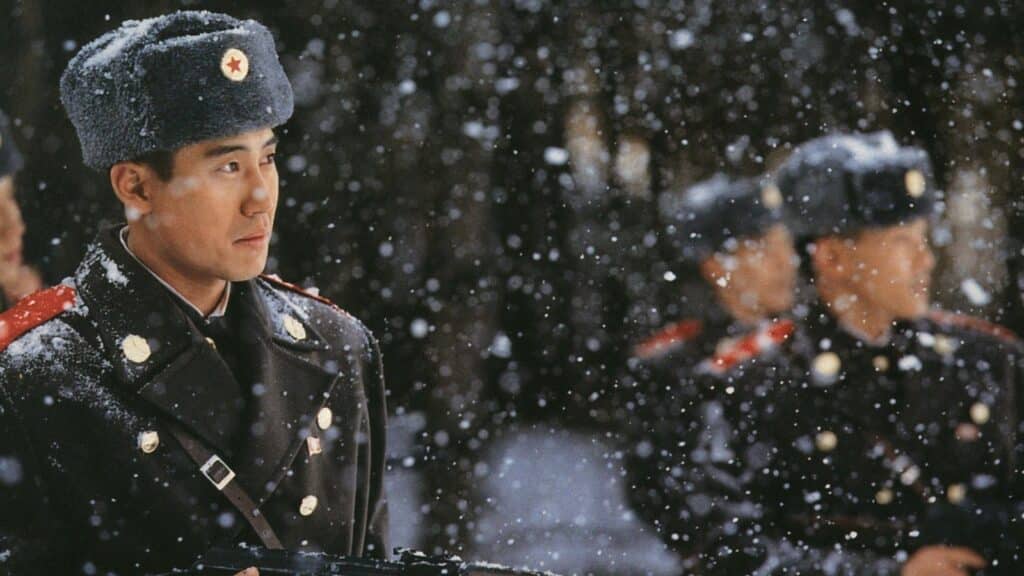Every month, we at The Spool select a filmmaker to explore in greater depth — their themes, their deeper concerns, how their works chart the history of cinema and the filmmaker’s own biography. For July, we honor the absurd humor and abject violence of South Korean filmmaker Park Chan-wook. Read the rest of our coverage here.
20 years ago, Park Chan-wook’s breakout directorial effort, Joint Security Area, came out in South Korea. It was an arduous process. It involved a studio recreation of the Demilitarized Zone (DMZ), months of research to attempt to replicate the North Korean side of the Joint Security Area without that country’s participation, and violent protests from the union that represented those that guarded the JSA. Nevertheless, it defied expectations for the then-unsung director, netting box office records.
Given the subject matter, it’s perhaps fitting that it often feels like two different works put in proximity to one another. One of those sides, a story of unlikely friendship ending in tragedy, is incredibly compelling. The other story, one of a prominent expatriate’s adult child returning to her country to investigate a crime, feels less so. And yet, they are one film, neither fully telling the story without the other.
At the behest of the Neutral Nations Supervisory Commission, Major Sophie E. Jean (Lee Young-ae) has been called to the DMZ. A North Korean guardhouse shooting left two North Korean soldiers dead and a third injured, and she’s to investigate it. It seems clear that South Korean soldier Sergeant Lee Soo-hyeok (Lee Byung-hun) did it. The why and how of it remain confusing, however. Injured North Korean Sergeant Oh Kyeong-pil (Song Kang-ho) insists Soo-hyeok snuck across and attacked unprovoked. Soo-hyeok, on the other hand, insists he was a kidnapping victim of the other side who only opened fire to escape.

Born and raised in Geneva and in the country of her father for the first time, Jean must find the truth. Otherwise, the tentative ceasefire between the two countries Koreas may explode into all-out violence and possible war. The Jean section, particularly early on, is the far less compelling story. Lee Young-ae is a charismatic performer, but the movie saddles her with some truly clunky English dialogue in the first 20 minutes. (The ADR for her lines makes it worse.)
When Lee Young-ae is communicating predominantly in Korean and focused on the investigation, she conveys intelligence well, showing without telling how good she is at her work. However, a subplot with her father undermines her even during this part. It’s not that she’s bad with the material; it’s that the material never feels integrated into the film, or all that interesting.
It’s in the flashbacks to what happened in the guardhouse that Joint Security Area really defines itself. Going back several months earlier, we see how Soo-hyeok and Kyeong-pil became unlikely friends, eventually dragging subordinate Private First Class Nam Sung-shik (Kim Tae-woo) and North Korean Soldier Jeong Woo-jin (Shin Ha-kyun) into their relationship.
The scenes of the characters getting to know and tease one another are by far the most compelling in the film. Given how the viewer already knows where this goes, the scenes have a bittersweet atmosphere and ever-escalating tension. Add in the fact that all four like to play with their guns akin to kids with toys, and it all carries a sense of looming dread.
In theme, style, and performance, it’s a tantalizing taste for what Park has to come.
While all four actors acquit themselves well in this section, Song is especially good. Playing the most veteran character of the quartet, he gives him an agreeable gruffness and an undeniable sense that he stopped caring about the ideology that divides his country from its southern neighbors a long time ago. Lee Byung-hun gets the majority of the screen time and does well with it, but Song is the one who demands the viewer’s attention. That he gets to be the last character we see before the film’s heartbreaking last shot feels right.
That said, it’s always fun to view a director’s early work and spot their growth edges, namely in terms of style. Joint Security Area certainly has that feel when it comes to Park. He does great work with light, or lack thereof, and the denatured pallet of the flashback scenes is effective in both enlisting a sense of nostalgia and fatalism.
You also feel him getting a sense for how to frame moments for maximum effect. The reoccurring shot of a bullet perforating the guardhouse window is a repeated standout that works every time. Again, the movie does struggle to be a fully integrated work, and that does make for a choppy viewing experience. However, when the film hits its stride, it proves a surprisingly funny and often powerful work. In theme, style, and performance, it’s a tantalizing taste for what Park has to come.